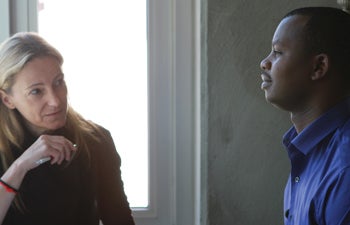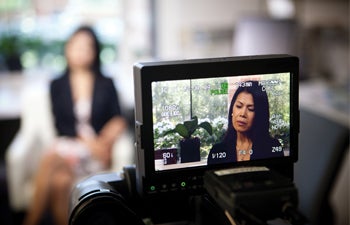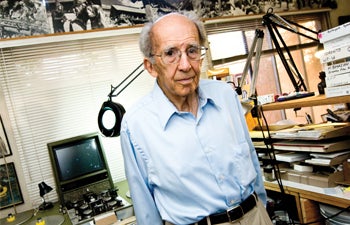Understanding the Universal
Freddy Mutanguha was 18 years old when his parents and four sisters were macheted to death by Hutu soldiers during the 1994 genocide in Rwanda. Mutanguha, a member of the Tutsi minority ethnic group, didn’t see the murders, but from a nearby friend’s house could hear his family’s screams over the soldiers singing.
His mission now is to create not only a memorial of survivor, perpetrator and rescuer testimony about that terrible time in his nation’s history, but also peace-building educational initiatives that foster resilience against violence, regardless of the political and economic climate.
The development of two distinct ethnic groups in Rwanda — the Hutus and Tutsis — arose in response to the divisive colonial rule of Belgium in the early 20th century. Tensions between the two groups then continued to escalate, especially after Rwanda gained independence in 1962 and the country became a highly centralized, repressive state with a regime characterized by the persecution and ethnic cleansing of the Tutsis. Cycles of violence continued, with Hutu extremists continually blaming Tutsis for the country’s growing economic and social woes. In 1994, when a plane carrying Rwanda President Juvénal Habyarimana, a Hutu, was shot down, violence began immediately with Hutu extremists determined to wipe out the Tutsi population.
It is difficult to ask Rwandans, still traumatized by a massacre that killed an estimated 1 million Tutsis, to talk about the genocide openly. But it is crucial to gather memories of those who bore witness.
The Rwandan people are not alone in trying to find a way to both preserve an historical record of a mass tragedy and share its lesson with the rest of the world.
The same impetus drove the founders of the USC Shoah Foundation — The Institute for Visual History and Education, which has collected video interviews with nearly 52,000 Holocaust survivors in 34 languages. Housed in USC Dornsife, it is the largest collection of its kind in the world. The institute is now committed to expanding its Visual History Archive and has begun incorporating testimonies from genocides other than the Holocaust.
Beginning in 2007, Mutanguha, country director of the Aegis Trust (Rwanda), a genocide prevention organization overseeing the Kigali Genocide Memorial in Rwanda, has worked with the institute to share methodologies on how to conduct interviews responsibly in Rwanda. Mutanguha and others from his organization are learning how to archive testimony and make it accessible to the world.
The first integration of non-Holocaust testimony into the Visual History Archive, the survivor testimonies about the genocide in Rwanda are expected to be followed by survivors of other genocides, said Karen Jungblut, the institute’s director of research and documentation.
“The range of experience of survivors and witnesses of genocides provides perspective that prejudice, bigotry and intolerance exist in many forms,” Jungblut said. “These collections represent multiple experiences that provide a pathway for understanding the universal.”
The technical craft of preserving and archiving Holocaust and Rwandan genocide testimony may be similar, but interviewing those who have survived such horrifying experiences only 18 years ago is a delicate task.
“Every community and culture has its own way of communicating its past and that can differ quite dramatically,” said Stephen Smith, the institute’s executive director. Smith founded The Holocaust Centre in England as well as the Aegis Trust, which works globally to prevent genocide and crimes against humanity.
“The appropriate way to take videos in the 1990s of Jewish witnesses is very different for those who are living 18 years after the Rwandan genocide or 30 years after the Cambodian genocide,” he said, adding that Cambodians are also starting to work with the institute in an effort to record accounts of its genocide, in which 2 million people were killed between 1975 and 1979.
Even within a cultural group, time can change the way memories are related. For example, Smith said, Holocaust survivors who spoke in 1946 were far more focused on reportage.
“Their testimonies were short, factual and to the point,” Smith said. “They focused on the key facts about the Nazi concentration camps and what they saw the perpetrators commit. It was almost like a police report.”
By the ’60s and ’70s, Holocaust survivors began giving longer autobiographical accounts that were more detailed and literary in nature, Smith said. By the ’90s survivors in greater numbers began talking about their personal experiences before, during and after the war. The stories, Smith said, become increasingly analytical.
“In the ’40s, they had just been persecuted, were highly traumatized and had the potential to still be persecuted,” Smith said. “They told their stories only to trusted authorities.”
To some degree, the situation mirrors what Rwandans and Cambodians face.
“People must feel safe in order to open up,” Smith said. “You don’t want to retraumatize them. Memory is emotional, cultural and spiritual. It’s more than historical.”
For that reason, it’s imperative that survivors receive support before, during and after the interviews. Smith said the support varies by country, but in Rwanda, for example, a survivors’ organization provides counseling, and if necessary, volunteers trained in mental health are summoned to speak to survivors giving testimony.

Freddy Mutanguha, a Rwandan genocide survivor himself, discusses his efforts to interview other survivors for the archive with Karen Jungblut, the institute’s director of research and documentation. Photo by by Ryan Fenton-Strauss.
Mutanguha said that at the outset, many Rwandan survivors refused to speak about the atrocities.
“They asked ‘Why should we do this?’” Mutanguha recalled. It was particularly difficult in the early days following the genocide, he said, when witnesses feared talking and had no wish to relive the nightmare.
But slowly, Mutanguha said, people began realizing that the process of speaking out would benefit their children and the younger generations.
“They wanted to help others,” Mutanguha said.
While there may be more than 100,000 potential survivors of the Rwandan genocide to interview, currently the USC Shoah Foundation is incorporating 66 testimonies about the genocide, 50 of which are from the Kigali Genocide Memorial, into the institute’s collection. Mutanguha himself has given a five-hour interview.
He recalled other agonizing interviews.
“My daughter said to me, ‘Papa, Papa, give me water,’” survivor Venuste Karasira recounted. “She had just learned to talk and was saying, ‘Give me water, I’m dying of thirst.’”
A militia soldier overheard her and taunting Karasira said, “‘Papa, this cockroach, let me come and show you.’”
Then one of the men stabbed the child with a knife. Karasira points to his head.
“Right here and it went through.”
Currently, the Rwandan testimonies are being transcribed and subtitled in English, Jungblut said. The Rwandan interviews will belong to the Kigali Genocide Memorial and Aegis Trust (Rwanda) and both the institute and Aegis Trust will disseminate the testimonies and integrate them into educational programs.
On one level there are similarities when comparing genocides, Mutanguha said.
“There is the process of preparation and execution of the genocide and the fact that people suffered,” he said. “These things one finds in each and every genocide.”
But every country and culture deals with genocide in its own way and time.
“Rwanda knew this was a story that had to be told and was absolutely aware of the Holocaust precedent — it had resonance,” Smith said. “In Cambodia, on the other hand, there is a cultural and personal expectation that individuals not share their stories with the wider community. Conversely, Rwanda wanted to place its genocide firmly in the public consciousness.”

Theary Seng, whose parents were killed in the Cambodian genocide and who spent five months in the Boeung Rei prison, gives her testimony to the USC Shoah Foundation. Photo by Kim Fox.
Cambodia’s genocide, led by the Communist Party, the Khmer Rouge, aimed to form a peasant farming society, much like Communist Party leader Mao Zedong had in China. In Cambodia, there were mass evacuations to the countryside where millions died of overwork, starvation and disease. The Khmer Rouge conducted regular and deadly purges to rid the country of the professional class, Buddhist monks and former government officials. The genocide, which took place from 1975 to 1979, claimed an estimated 2 million lives.
Rwanda’s readiness to deal with the mass killings is demonstrated by the fact that trials for genocide crimes occurred five years before the first Cambodian trials — even though Cambodia’s atrocities had taken place 20 years before Rwanda’s.
How stories are told varies widely among cultures.
“In Rwanda, the narrative tradition is not about chronology,” Smith said. “It’s about community values and family; the sense of abandonment by the international community when the United Nations left. What happened was very, very local. It was hand-to-hand fighting and the victims knew everyone involved in the chain of activity.”
Therefore, methodology in interviewing differs from country to country.
“You can’t force one method to be used,” Smith said.
Another challenge in interviewing Rwandan genocide survivors is helping them overcome their fear that they or their families can still be punished by the perpetrators in some way.
For that reason, people can give their testimony but ask that the videos not be shown to anyone or put online until a future date. This is also the case with Holocaust survivors. The institute has agreed not to make public approximately 400 Holocaust interviews until a certain amount of time has passed.
Additionally, the institute is working with the Armenian Film Foundation, which has documented the Armenian genocide that began in 1915 and led to the deaths of as many as 1.5 million Armenians in Ottoman-ruled Turkey.
In this case, the foundation is working to update its testimonies from film to digital media and make them available to the world.

Before his death in 2010, Armenian genocide survivor J. Michael Hagopian filmed more than 400 Armenian survivors. Their accounts are being integrated into the institute’s Visual History Archive. Photo courtesy of the USC Shoah Foundation.
Armenian genocide survivor J. Michael Hagopian began conducting interviews with eyewitnesses and survivors in 1966. He interviewed them through the ’60s, ’70s, ’80s, ’90s, up to 2005. Over the years, he filmed — this was before the use of videotape — more than 400 Armenian survivors and witnesses and has used some of the interviews in documentaries.
In 1979, he established the Armenian Film Foundation in Thousand Oaks, Calif., to preserve Armenian culture and heritage. Hagopian, who earned his Ph.D. at Harvard University, worked until his death in 2010 at age 97.
Carla Garapedian, project leader of the Armenian Film Foundation’s digitization project and Hagopian’s longtime associate, sought to collaborate with the institute.
“We wanted to see how we could make the whole project more widely available,” Garapedian said. “And the USC Shoah Foundation was looking to expand its collection. So we started discussions.”
Hagopian traveled the world finding people to provide firsthand accounts of the Armenian genocide. His group filmed the interviews in 10 languages, including Armenian, Greek, Russian and Turkish.
Funding is being sought to support the integration of these interviews into the Visual History Archive so they will become accessible to a global audience.
While the Holocaust interviews are sometimes many hours long — the average interview is 2 1/2 hours but one runs as long as 17 hours — the Armenian accounts were much shorter for technical reasons. Film was expensive and the filmmakers had to be very frugal, often using only one or two rolls of film for each interview, Garapedian said.
“Very often most events are described in detail, but almost monotone,” she added. “Often they are almost unemotional. Someone who was eight or nine years old when the Armenian genocide occurred will describe the executions of a father, mother and describe children being sent on death marches. Sometimes they feared talking, and whispered as if perpetrators are just around the corner.”
In one testimony, survivor Sam Kadorian — whose cheek was scarred from a Turkish bayonet — described an abhorrent scene:
“I saw with my own eyes, when a woman didn’t have any milk in her breasts, so one of these Turkish soldiers grabbed the baby by the arm, tossed the little thing up into the air. The Turkish solider caught it with a bayonet on his rifle.”
Adding other genocides to the institute’s collection will not dilute the singular experience of the Holocaust, Jungblut said.
“Everything adds. Nothing takes away,” she said. “We’re looking for a body of work that encompasses the experience and helps us understand the commonality of these experiences from the Armenian genocide to the Jewish Holocaust to Cambodia, Rwanda, and others.”
Although each genocide is horrific in its own way, survivors and witnesses can see similarities.
“Armenian survivors and Holocaust survivors can really relate,” Garapedian said. “They see things going from normal to kind of bad, and they can’t quite believe it. Then they’re pushed out of their homes and they can’t believe it. Armenians hear Holocaust survivors talking about it and say ‘that’s how we felt.’”
Mutanguha agreed.
“There are so many points of connection with the Holocaust survivors,” he said. “They know what it means to experience the killing of an entire people. They witnessed the affects of propaganda, the misuse of media and newspapers to dehumanize them. Our experience is not identical, but we share the struggle for survival in common.”
Equally as important as assembling and archiving the testimonies is how they are disseminated to the world. About 1,100 of the 52,000 testimonies are available on the Web via the institute’s Visual History Archive Online. The complete archive can be accessed through 40 institutes (including USC) in 10 countries. In addition, a number of museums, libraries, schools and synagogues have licensed copies of specific testimony.
The testimonies have been used in university courses, including gender studies, history, Jewish studies, psychology, film studies, anthropology and Catholic theology.
Dispersing the interviews is an ongoing project. The institute has developed a series of resources and products that incorporate video testimony from its archive for the benefit of secondary schools. One example is the Holocaust education program Echoes and Reflections, a three-way partnership with the institute, the Anti-Defamation League and Yad Vashem, the Holocaust museum in Jerusalem, Israel.
The work continues with the launch of IWitness, a new educational Web site, which enables teachers and their students to explore 1,000 video testimonies from survivors and witnesses and use the testimonies in their lessons. The institute is currently working with teachers from throughout the United States and around the world to fine-tune IWitness.
Through all these efforts, Mutanguha’s hope — and the hope of all connected to the institute — is that the testimonies and the horror they reveal will not be seen as an anomaly.
“Someone, say, from Mexico, listening to my testimony should know what it means,” he said. “A human being has suffered. It happened in Rwanda and it can happen anywhere.”
Read more articles from the Fall 2012/Winter 2013 issue of USC Dornsife Magazine